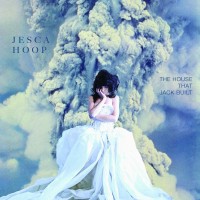 Jesca Hoop: The House That Jack Built (Bella Union, 6/26/12)
Jesca Hoop: The House That Jack Built (Bella Union, 6/26/12)
“Born To”
Northern California-born signer/songwriter Jesca Hoop (a current resident of Manchester, England) has made quite the impression on people in high places. Garnering endorsements from the likes of Elbow’s Guy Garvey, Peter Gabriel, and Tom Waits (for whom she used to nanny, and who has described her music as being “like going swimming in a lake at night”), Hoop has established herself as well-crafted songstress who relies on her strong voice and pop sensibilities to impel her songs forward. But the support from her tried-and-true forebears isn’t unfounded; on her new album, The House That Jack Built, Hoop disinters the raw talent and musical vision to back up all the hype surrounding her.
From the start of the album — Hoop’s third full-length effort and direct follow-up to 2009 album Hunting My Dress — it’s apparent that she has something special up her sleeve. The thudding pop of first single and opening track “Born To” hurls you headlong into forlorn catchiness and a hook-laden chorus that rings out before the first 40 seconds are up. The song is the window needed to enter the “house,” and right when you’ve climbed through, you’re given a moment to catch your breath on the more subdued “Pack Animal.”
The album, for the most part, follows this pattern, oscillating between the revved-up poppiness of songs like “Hospital (Win Your Love)” and then dissipating into the more stringent and softened offerings like “DNR.” Meshing electric and acoustic guitars with electro-beat infusions and synth-heavy textures, as well as softer harmony-driven arrangements, The House That Jack Built feels both grandiose and subdued. This is perhaps due to the fact that three different producers contributed to the record’s creation, but each twist and turn offers a breath of fresh air, with the makeup of the album fitting somewhere between the musical posturing of Florence and the Machine and the erudite sentimentalism of Neko Case. (“Deeper Devastation” feels like a page torn right out of the Middle Cyclone songbook.)
Much like the music, the lyrical themes here are just as diverse. Written and recorded shortly after the death of her father, the album ushers in whirlwinds of emotions and sentiments, of both heartache and humor, focusing on everything from Greek tragedies (“Peacemaker”) to street art (“Ode to Banksy”) to Hoop’s own turbulent relationship with her father (the title track) and everything between. With these themes in tow, the album covers a lot of ground in its nearly 40-minute duration, and it is never satisfied to sit still in one place for too long.
But while there are so many different ideas, feelings, and meditations coursing through the album’s veins, The House That Jack Built doesn’t feel hamstrung or hindered. Instead, Hoop has molded her raw emotion and coping mechanisms into artwork, and the result is nothing short of impressive. At times broad in scope, the album is brought down to earth by Hoop’s personal anecdotes and feelings of angst and restlessness, perpetuating an impressive range of which not many songwriters are capable. The musical prowess captured on the album is enough to turn plenty of heads — and not just those of Waits and Gabriel.

